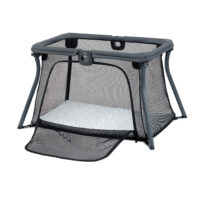Most babies are ready to drop down to one nap per day between 15 months and their second birthday. Even though it makes it easier to leave the house when baby isn’t sleeping as much, this isn’t something you want to rush into.
For parents wondering when to drop to one nap, you’ll find what you need to know below. Since every baby is unique in their needs, you’ll also find a handy guide on signs that your baby is ready to drop to one nap per day and how to ease them into this transition.
Signs Your Baby is Ready to Drop to One Nap Per Day
Since babies develop differently, you’ll want to wait until your baby shows signs they are ready to have only one nap per day. This can happen as early as a year for some babies, even though most aren’t ready until around 15-18 months. There are also toddlers that continue taking a second nap until they are two years old.
This is something that has to do with your baby’s specific needs- don’t rush the process and look for these signs that show your baby might be ready to make that transition.
1. Your child has changes in their sleep schedule.
Toddlers rely on their natural sleep-wake cycle to ensure they are getting the rest they need. When they are ready to transition to one nap, you may notice changes in their sleep schedule. They may have difficulty falling asleep at one or both of their naps or they might start waking up earlier. Your child also might not get as many hours of sleep at night if they are still taking two naps and they don’t need them- they might wake up earlier in the morning or start struggling with sleeping through the night.
2. Your child is getting the recommended amount of sleep without a nap.
Once babies are older and their stomachs are bigger, they may sleep longer hours at night because they aren’t waking up to feed. Add the total hours your baby is sleeping at night to the number of naps they are taking to get the total amount. According to the CDC, a toddler between ages 1 and 3 should be sleeping 11-14 hours in a 24-hour period. When kids are younger, they’re more likely to be on the higher end of that spectrum toward the 14 hours of sleep.
3. Your child is experiencing sleep regression.
Sleep regression happens when a child starts to resist their normal sleeping schedule. They might resist napping, battle you at night, and be generally crankier because they are sleeping less. Even though sleep regression can be exhausting for all parties involved, it’s a frequent occurrence for kids between 15 and 18 months. It is a sign that your child has newfound independence- that’s the reason they are resisting what you want. You can find out more about how to handle sleep regression here.
4. Your child can skip a nap and still remain alert.
The goal with napping is that your child is rested enough they remain alert and in a good mood from wake time until their first nap and then from their first nap until bedtime. If your child is showing signs they’re ready to transition and you try it, you should expect a little resistance at first. Keep in mind this resistance doesn’t always mean they aren’t ready – your child may just need a little time to adjust. If it has been at least 1-2 weeks and there still isn’t any change, then you may want to continue two naps until your child is a little older.
Signs Your Child Still Needs Two Naps
There are also several signs that your child might still need those two naps. If you notice these things, you’ll want to wait until your child is a little older before trying to drop to one nap:
- Your child is less than one year old. Up until your child is a year, they need at least two naps for proper growth and development.
- There is fussiness or crankiness when your child does miss their nap. They may become restless, cranky, or throw tantrums.
- Your toddler is experiencing changes in their nap schedule. This might happen if they start daycare, experience an illness, or have a new sibling.
- There is some resistance like playing or fussiness at naptime, but your child is sleeping for at least an hour.
- Daytime car rides still put your child to sleep.
- Your child usually takes two good naps at home. They may miss these naps when things are exciting or when you are out doing something.
How to Transition to One Nap
When you do decide that your baby is ready to switch to one nap per day, it’s important to ease into the transition. In most cases, kids who take naps take one in the morning and one in the afternoon. Once you are ready to cut down to a single nap each day, you’ll need to push the morning nap later. Ideally, you’ll want there to be the same hours of wake time before and after the nap.
For kids who seem more flexible with sleep, you can push their morning nap back as much as 30 minutes to an hour per day until you reach the desired time. If your child has trouble making the switch, then it’s best to move nap time back by 10-minute increments. While this takes a little longer, you should still be able to push their nap back by an hour without any problems the first week.
Expect as you make this transition that your child seems a little crankier as it gets close to nighttime. Until you get their nap pushed back to where there isn’t too long of a break between their nap and bedtime, they might experience nighttime crankiness. In some cases, you may want to put them to bed a little earlier at night. If you wait until they are cranky and overtired before giving your toddler a nap or putting them to bed, it’s more likely they will become overtired. Kids who are overtired are actually less likely to get a good night’s sleep.
Regardless of how quickly transition, you’ll want to use the same routine before naptime as you usually do. Give your child stimulation by playing or interacting with them and then do at least a half-hour of calming activities before their nap.
What time should I give my child their nap?
The best time to give your child their nap is right during the middle of the day. For example, if your child usually takes a 3-hour nap and sleeps 11 hours at night, you’ll want to have the first nap about 5 hours after they wake up for the day. If your child wakes up around 7 a.m., you’ll give them their nap at noon. Then, they should wake up by 3 p.m. and be ready for bed by 8 p.m.
Even though a mid-day nap is ideal, it doesn’t always work with your schedule. If you can’t go for a midday nap, it’s better to have it later in the afternoon. Kids are more likely to be cranky toward bedtime at night if they have longer wake time than they would be during the morning hours. This is likely because they are skipping their nap after 11 hours of sleep at night, rather than being awake too long after just three hours of sleep.
Final Word
For parents wondering when to drop to one nap, the average timeline is sometime between 12 and 24 months. However, this guideline spans over a whole year and it can be hard to narrow down when the perfect time is. Even though your baby will be ready around this time, it’s important to wait until your baby is physically and physiologically ready for that change. For most babies, this won’t happen until at least 15 months.
Your baby’s nap schedule affects things like their mood and energy level through the day, as well as how soundly they sleep at night. Even though newborns might spend as much as 14-17 hours sleeping total, their need for sleep starts to drop as they get older. After your baby reaches a year, they may even be ready to start napping less during the day.
The best indicator is your child’s behavior and how their sleep schedule affects that. Once you are ready to drop to one nap, adjust your child’s nap gradually until it’s pushed back to the time you want it to be. This allows for an easier transition and won’t upset your baby’s natural sleep/wake cycle as much.







